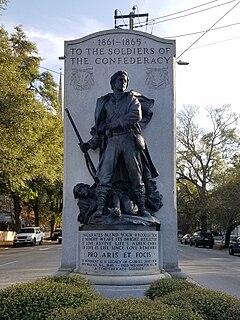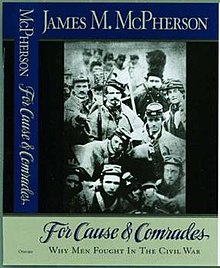
The American Civil War was a civil war in the United States from 1861 to 1865, fought between the northern United States and the southern United States. The civil war began primarily as a result of the long-standing controversy over the enslavement of black people. War broke out in April 1861 when secessionist forces attacked Fort Sumter in South Carolina shortly after Abraham Lincoln had been inaugurated as the President of the United States. The loyalists of the Union in the North, which also included some geographically western and southern states, proclaimed support for the Constitution. They faced secessionists of the Confederate States in the South, who advocated for states' rights in order to uphold slavery.

The Confederate States of America —commonly referred to as the Confederacy—was an unrecognized republic in North America that existed from 1861 to 1865. The Confederacy was originally formed by seven secessionist slave-holding states—South Carolina, Mississippi, Florida, Alabama, Georgia, Louisiana, and Texas—in the Lower South region of the United States, whose economy was heavily dependent upon agriculture, particularly cotton, and a plantation system that relied upon the labor of African-American slaves. Convinced that the institution of slavery was threatened by the November 1860 election of Republican candidate Abraham Lincoln to the U.S. presidency on a platform which opposed the expansion of slavery into the western territories, the Confederacy declared its secession in rebellion against the United States, with the loyal states becoming known as the Union during the ensuing American Civil War. Confederate Vice President Alexander H. Stephens described its ideology as being centrally based "upon the great truth that the negro is not equal to the white man; that slavery, subordination to the superior race, is his natural and normal condition".

The Emancipation Proclamation, or Proclamation 95, was a presidential proclamation and executive order issued by United States President Abraham Lincoln on September 22, 1862, and effective as of January 1, 1863. It changed the legal status under federal law of more than 3.5 million enslaved African Americans in the Confederate states from slave to free. As soon as a slave escaped the control of the Confederate government, either by running away across Union lines or through the advance of federal troops, the slave was permanently free. Ultimately, the Union victory brought the proclamation into effect in all of the former Confederacy. The remaining slaves, those in the areas not in revolt, were freed by state action, or by the Thirteenth Amendment to the United States Constitution, ratified in December 1865.

The Confederate States Army was the military land force of the Confederate States of America during the American Civil War (1861–1865), fighting against the United States forces. On February 28, 1861, the Provisional Confederate Congress established a provisional volunteer army and gave control over military operations and authority for mustering state forces and volunteers to the newly chosen Confederate president, Jefferson Davis. Davis was a graduate of the U.S. Military Academy, and colonel of a volunteer regiment during the Mexican–American War. He had also been a United States Senator from Mississippi and U.S. Secretary of War under President Franklin Pierce. On March 1, 1861, on behalf of the Confederate government, Davis assumed control of the military situation at Charleston, South Carolina, where South Carolina state militia besieged Fort Sumter in Charleston harbor, held by a small U.S. Army garrison. By March 1861, the Provisional Confederate Congress expanded the provisional forces and established a more permanent Confederate States Army.

The United States Colored Troops (USCT) were regiments in the United States Army composed primarily of African-American (colored) soldiers, although members of other minority groups also served with the units. They were first recruited during the American Civil War, and by the end of that war in April 1865, the 175 USCT regiments constituted about one-tenth of the manpower of the Union Army. About 20% of USCT soldiers died, a rate about 35% higher than that for white Union troops. Despite heavy casualties, many fought with distinction, 15 USCT soldiers receiving the Medal of Honor and numerous others receiving other honors.

During the American Civil War, the Union Army referred to the United States Army, the land force that fought to preserve the Union of the collective states. Also known as the Federal Army, it proved essential to the preservation of the United States as a working, viable republic.

Historians debating the origins of the American Civil War focus on the reasons why seven Southern states declared their secession from the United States, why they united to form the Confederate States of America, and why the North refused to let them go. While virtually all historians in the 21st century agree that conflicts over slavery caused the war, they disagree sharply regarding which kinds of conflict—ideological, economic, political, or social—were most important.

James M. "Jim" McPherson is an American Civil War historian, and is the George Henry Davis '86 Professor Emeritus of United States History at Princeton University. He received the 1989 Pulitzer Prize for Battle Cry of Freedom: The Civil War Era. McPherson was the president of the American Historical Association in 2003, and is a member of the editorial board of Encyclopædia Britannica.
Neo-Confederates or Southern nationalists are groups and individuals who use historical negationism to portray the Confederate States of America and its actions in the American Civil War in a positive light. Some Neo-Confederate organizations, such as the League of the South, continue to advocate for the secession of the former Confederate States.

Mississippi was the second southern state to declare its secession from the United States, doing so on January 9, 1861. It joined with six other southern slave-holding states to form the Confederacy on February 4, 1861. Mississippi's location along the lengthy Mississippi River made it strategically important to both the Union and the Confederacy; dozens of battles were fought in the state as armies repeatedly clashed near key towns and transportation nodes.

South Carolina was the first state to secede from the Union in December 1860, and was one of the founding member states of the Confederacy in February 1861. The bombardment of the beleaguered U.S. garrison at Fort Sumter in Charleston Harbor on April 12, 1861 is generally recognized as the first military engagement of the war.

Georgia was one of the original seven slave states that formed the Confederate States of America in February 1861, triggering the U.S. Civil War. The state governor, Democrat Joseph E. Brown, wanted locally raised troops to be used only for the defence of Georgia, in defiance of Confederate president Jefferson Davis, who wanted to deploy them on other battlefronts. When the Union blockade prevented Georgia from exporting its plentiful cotton in exchange for key imports, Brown ordered farmers to grow food instead, but the breakdown of transport systems led to desperate shortages.

Virginia became a prominent part of the Confederacy when it joined during the American Civil War. As a Southern slave-holding state, Virginia held a state convention to deal with the secession crisis, and voted against secession on April 4, 1861. Opinion shifted after April 15, when U.S. President Abraham Lincoln called for troops from all states still in the Union to put down the rebellion, following the capture of Fort Sumter, and the Virginia convention voted to declare secession from the Union. A Unionist government was established in Wheeling and the new state of West Virginia was created by an act of Congress from 50 counties of western Virginia, making it the only state to lose territory as a consequence of the war.

The 25th Regiment Wisconsin Volunteer Infantry was an infantry regiment that served in the Union Army during the American Civil War.

Louisiana was a dominant population center in the southwest of the Confederate States of America, controlling the wealthy trade center of New Orleans, and contributing the French Creole and Cajun populations to the demographic composition of a predominantly Anglo-American country. In the antebellum period, Louisiana was a slave state, where enslaved African Americans had comprised the majority of the population during the eighteenth-century French and Spanish dominations. By the time the United States acquired the territory (1803) and Louisiana became a state (1812), the institution of slavery was entrenched. By 1860, 47% of the state's population were enslaved, though the state also had one of the largest free black populations in the United States. Much of the white population, particularly in the cities, supported slavery, while pockets of support for the U.S. and its government existed in the more rural areas.

With the outbreak of the American Civil War, the northwestern state of Wisconsin raised 91,379 soldiers for the Union Army, organized into 53 infantry regiments, 4 cavalry regiments, a company of Berdan's sharpshooters, 13 light artillery batteries and 1 unit of heavy artillery. Most of the Wisconsin troops served in the Western Theater, although several regiments served in Eastern armies, including three regiments within the famed Iron Brigade. 3,794 were killed in action or mortally wounded, 8,022 died of disease, and 400 were killed in accidents. The total mortality was 12,216 men, about 13.4 percent of total enlistments.
Historiographic issues about the American Civil War include the name of the war, the origins or causes of the war, and President Abraham Lincoln's views and goals regarding slavery. Historiography examines how the past has been viewed or interpreted.

Located at the plaza of South Third and Dock Street in downtown Wilmington, North Carolina, the bronze and granite Confederate Memorial stands honoring soldiers who fought for The Confederacy.

Slavery played the central role during the American Civil War. The primary catalyst for secession was slavery, especially Southern political leaders' resistance to attempts by Northern antislavery political forces to block the expansion of slavery into the western territories. Slave life went through great changes, as the South saw Union Armies take control of broad areas of land. During and before the war, slaves played an active role in their own emancipation, and thousands of slaves escaped from bondage during the war. On January 1, 1863, President Abraham Lincoln announced the Emancipation Proclamation, making 3 million blacks legally free. In the war, both sides used African Americans for military purposes; in the South as slave labor and in the north as wage labor and military volunteers. Over 100,000 ex-slaves fought for the Union and over 500,000 fled their plantations for Union lines. Religiosity and cultural expression also developed greatly during the war.

Chauncey Herbert Cooke was a United States Army soldier from Buffalo County, Wisconsin who fought in the American Civil War. After the war ended, he worked as a schoolteacher, teaching former slaves in Texas.

















